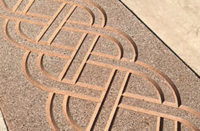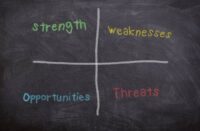 It’s one of the truest and simplest maxims in the world of business: You won’t be successful if people don’t know about you. Sales and marketing techniques are key to getting your name out there.
It’s one of the truest and simplest maxims in the world of business: You won’t be successful if people don’t know about you. Sales and marketing techniques are key to getting your name out there.
If prospective customers are ever going to buy the products or services you’re selling, they need to know you exist and that your company’s products and/or services are worth buying. In short, you need to sell yourself in the marketplace. The best and time-honored way to do that is through the effective use of various marketing tactics. These are designed to increase awareness of your company’s strengths and experience.
The decorative concrete industry is currently one of the fastest growing fields in the nation. Consequently, more contractors are entering the marketplace. To meet the growing demand among architects and consumers alike, decorative concrete specialists must do more to market themselves.
If you’re like most contractors, however, your background is more in the skilled trades than in sales and marketing. You may be unsure about the best and most cost-effective ways of reaching your potential audience. Direct mail? Television commercials? Public relations? Trade shows? Brochures? All of these tried-and-true tactics can be useful. However, you have to choose the ones that are right for your business and within your limited budget.
Home & Garden Shows: A Must
For the decorative concrete contractor just starting out, particularly those who wish to concentrate on the residential market, participation in a local home and garden show is an excellent way to get the word out about your work. Also effective are the various “Parade of Homes” exhibitions. These are traditionally sponsored by local or regional chapters of the National Association of Home Builders (NAHB). Events focusing on more specialized subcategories, like spa and pool deck installation, are worth considering, too. Those who attend these events are exactly the people you want to reach: Builders, architects, designers, and consumers. Some who may be looking for a quality contractor. Others might be eager to know more about the relatively new world of decorative concrete.
Darby Hebert runs a Kwik Kerb Decorative Concrete franchise in the Charleston, SC, area. He has been in business just 18 months. “Last year, we did the landscaping and remodeling expo they have each year here in Charleston, and that did really well for us. We generated close to 200 quality sales leads.”
If you choose to participate in a local industry expo, you might consider offering your services for free to the show sponsors, installing a section of decorative concrete floor that shows off your stamping or staining skills. Your work will be on display in a high-traffic area, generating significant awareness of your name and quality of craftsmanship. If you’re an exhibitor, you’d be well advised to have brochures, media kits, business cards and other printed materials available to distribute to those who visit your booth.
Suppliers Can Help
Oftentimes, the manufacturer from whom you buy your decorative concrete products can assist you in these efforts. At Specialty Concrete Products, the company is happy to help contractors generate postcards, brochures, even videos and CD-ROMs for use in marketing themselves. “We want our customers to be successful, and we’ll help them in any way we can,” says Jeff Hartzog, International Sales Manager. “We help them put promotional materials together at cost. Then they compile or acquire a mailing list and send them out. We can even help them get a website up and running, if that’s the way they want to go.”
Because decorative concrete is such a visual product, a promotional video is an excellent method for educating potential clients. Video can show how to turn conventional grey concrete surfaces into something truly extraordinary. “When you take a video to prospective customers, you’re doing two things,” said Hartzog. “First, you’re educating them about the attractive option of decorative concrete, which they may not know about yet, and second, you’re showing them that you’re the person they should hire to do their job.”
Videos should be limited to 8-10 minutes in length to avoid boring your audience. They should include “before, during and after” shots of several different projects, tightly edited for maximum effectiveness. Producing your master video represents most of the cost involved; making multiple copies to leave with your prospects is very inexpensive.
Know Your Customers
The visual presentation of quality work goes a long way in convincing your audience to hire you. Jeff Chambers, a veteran in decorative concrete installation in the Southern California market, concentrates almost exclusively on retail commercial applications, especially chain stores and restaurants. He has learned the wisdom of researching how an organization is structured. Chambers approaches the right decision-makers and offers a compelling case through Power Point and other computer-based presentations.
“I have the added advantage of doing my installation work right where everyone can see it,” Chambers notes. “In malls and shopping centers, if I’m putting in a decorative concrete floor in a high-end retail space, the architects and contractors involved in other jobs in the same area walk by and see the finished floor as well as the skill and care we put into our work.”
Chambers has a relationship with Crossfield Products Corp.’s Miracote Division. Ron Borum, Corporate Vice President, says one of the reasons Chambers has been successful is his ability to be flexible to meet retail clients’ demanding timetables. “He presents his work professionally, with touch-and-feel samples and high-quality photos of completed jobs, and then he’s able to respond almost immediately if need be,” he observes.
High-Quality Portable Samples
While photos and videos do a fine job of showing off your work, even better are actual samples that you can take with you when making sales calls. The accepted standard is 2′ x 2′ squares that adequately represent patterns, textures and colors, but they can sometimes be awkward and heavy to transport. Some contractors are now using a relatively new alternative that is far more convenient and portable. 51⁄2″ round samples made from pure color hardener mixed with water and formed in plastic laboratory petri dishes.
Perhaps better still is the option of pouring sample areas in your warehouse, showroom, or outside your building and then inviting architects and designers to come for a visit, either by appointment or via an open-house event. This method allows businesses to display larger patterns and textures. It also allows customers to examine the product themselves.
Should You Be On TV?
Some marketing tactics are inappropriate for certain types of businesses. Others can be too expensive when weighed against the amount of business they help draw. For example, TV commercials have long been regarded as undignified for lawyers, doctors and other professionals. Some businesses that sell a visually oriented product or service have found television to be a very persuasive medium to get their message across. Decorative concrete falls in that category, and some contractors have found TV ads to be well worth the investment.
Darby Hebert was initially hesitant to spend the money to produce a TV spot, “but we finally bit the bullet and got a 30-second ad. We’ve been running it during the local morning news and during a lunch-hour program called “Midday” shown here in Charleston It has pulled really well for us.”
Hebert also learned first hand about the wonders of public relations. Through inquiries with the producers of the “Midday” program, Hebert found himself featured in a six-minute “what’s new in home improvement” segment on the show. On the show, he demonstrated how to install decorated concrete. “By the time we finished doing that live appearance, I found a half-dozen messages on my cell phone from people who’d seen it and wanted to know more. That’s what they call free advertising!”
The Internet continues to make inroads into the ways every industry does business. Contractors would be foolish to ignore the opportunities and valuable information awaiting them online. A number of industry Web sites are available on which contractors may post information and list services. Such websites can be used either for free or a modest fee to reach more customers. These include:
www.thebluebook.com
www.arcat.com
www.concretenetwork.com
There’s Nothing Like Word of Mouth
While visual aids, TV ads, trade show participation and other techniques can be very helpful in marketing yourself, industry insiders are virtually unanimous. In their opinion that the best advertising in the decorative concrete field is word of mouth. “It’s an extremely visual product,” says Hartzog, “so the main thing is to put in quality work, because the product sells itself. A great job for a satisfied customer spreads the word for you. You go into a residential neighborhood and put in a quality driveway or patio or pool deck, and soon everybody sees it, and everybody wants one.”
That’s why it’s so critical to make sure your customers are satisfied with your work. You’ll want to enlist their help in getting the word out. Don’t forget to take quality color photos and/or shoot video, both before and after, for use in future marketing efforts. Secure their permission to use their names as references. Additionally, ask if you may send prospects by the customers’ houses to inspect your work first-hand.
“Satisfied customers who will recommend you to others are worth their weight in gold,” notes Hartzog.















